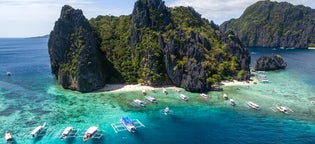Best places in the Philippines
Destinations

Best places in the Philippines
2,677 results match your search
Refine the results by using the filters
Sort by: Popular

4.6
2,480 reviews
Puerto Princesa Subterranean River National Park, Puerto Princesa, Palawan, Philippines
Underground River
Puerto Princesa Underground River (PPUR) Located about 80 km north of Puerto Princesa in Palawan lies an underground river known as the Puerto Princesa Subterranean River National Park. More commo

4.8
689 reviews
Chocolate Hills, Loay Interior Road, Carmen, Bohol, Philippines
Chocolate Hills
The Chocolate Hills are a geological formation of as many as 1,776 conical hills in Bohol, spread over 50 sq km across the towns of Carmen, Batuan, and Sagbayan. The hills are covered in green grass that turns brown during the dry season of February to June, transforming them into rows of seemingly

4.9
155 reviews
Kayangan Lake, Coron, Palawan, Philippines
Kayangan Lake
Kayangan Lake Kayangan Lake in Palawan, is one of the most popular Coron tourist spots and is included in Coron island-hopping tours that depart from town on a regular basis. It is also one of the cleanest lakes in Asia. How to Get There Getting to Kayangan Lake itself involves quite a long t

4.5
3,666 reviews
Kawasan Falls, Badian, Cebu, Philippines
Kawasan Falls
Kawasan Falls Cebu is a province in Visayas region of the Philippines that is often recognized as a premier destination. This is so because the island has numerous white sand beaches lining its shore and in islands within its district. Many local and foreign tourists make their way here throughou

Install the Philippines’ biggest travel app
Download the Philippines’ biggest travel marketplace to your phone to manage your entire trip in one place
Scan this QR code with your phone camera and press the link that appears to add the Philippines’ biggest travel marketplace into your pocket. Enter your phone number or email address to receive an SMS or email with the download link.











